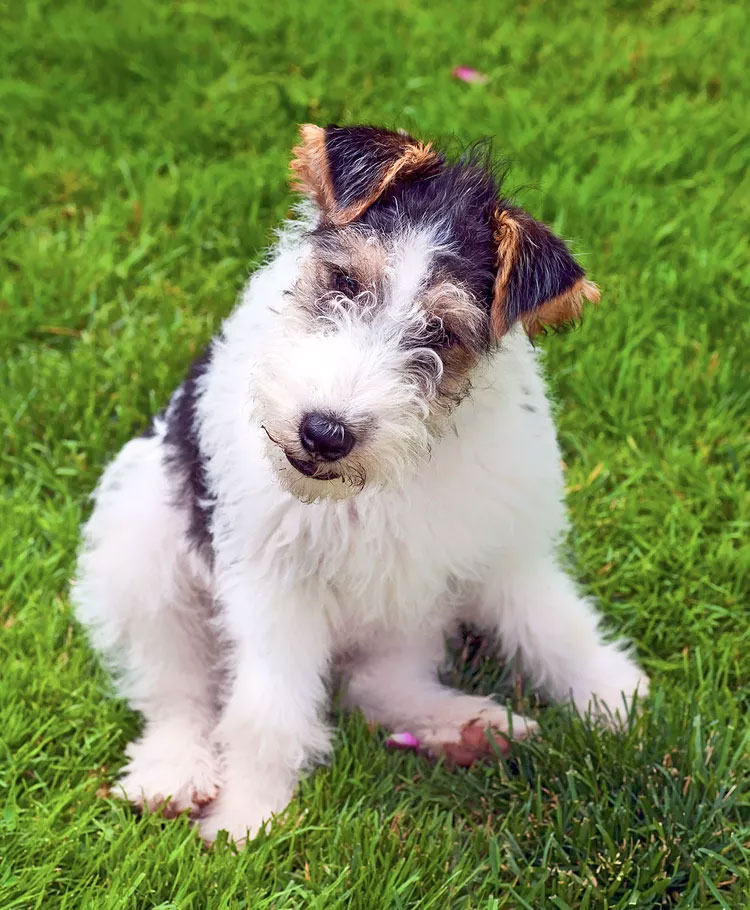
Wire Fox Terrier Overview
| OFFICIAL NAME | Wire Fox Terrier |
| COMMON NAME | Wire Fox Terrier |
| PET HEIGHT | 15 to 15 inches |
| PET WEIGHT | 15 to 18 pounds |
| LIFESPAN | 12 to 15 years |
| GOOD WITH | children, dogs, families |
| TEMPERAMENT | friendly, outgoing, playful |
| INTELLIGENCE | high |
| SHEDDING AMOUNT | infrequent |
| EXERCISE NEEDS | high |
| ENERGY LEVEL | active |
| VOCAL LEVEL | when necessary |
| DROOL AMOUNT | low |
| BREED GROUP | terrier |
| BREED SIZE | small (0-25 lbs.) |
| COAT LENGTH | medium, wiry |
| COLORS | black, fawn, white |
| PATTERNS | bicolor, tricolor |
| OTHER TRAITS | apartment-friendly, easy to train, good hiking companion, high potential for weight gain, high prey drive, requires lots of grooming, strong loyalty tendencies |
Wire fox terriers are small, peppy dogs with wiry white hair and an adventurous spirit. Originally developed to flush foxes from their dens during British foxhunts, today these dogs make great companions for active families. They love to walk, romp, play, and learn new tricks, thanks to their abundant energy and high intelligence. Despite their cheery dispositions and up-for-anything personalities, this breed remains relatively uncommon in the United States.
"Life with a wire fox terrier is never boring," says Sylvalyn Hammond, DVM and veterinary advisor for Pawp. "A true terrier at heart, they are always ready for adventure and will provide plenty of entertainment."
Appearance
These fun-loving little dogs have a very distinctive appearance that makes them easy to identify. Standing roughly 15 inches tall and weighing between 15–18 pounds, these small-but-mighty dogs have long snouts that tend to jut outward and away from their bodies and short tails that point straight up in the air. They're often described as standing on their tippy-toes, because their posture is often poised, alert, and ready for action.
Small, dark, deeply set eyes give the wire fox terrier his friendly and intelligent expression. His ears are small and V-shaped, folding over into tidy triangles that fall gently onto his forehead. Some have wavy goatees hanging down from their chins, too.
As this breed's name suggests, wire fox terriers have rough, wiry coats with a range of markings. These dogs tend to be primarily white all over, with some hints of black, tan, or a combination of the two. Underneath their dense, stiff outer coats, which are often described as wavy or crinkly, these mostly white wire fox terriers have a soft, fine undercoat.
Wire fox terrier shedding is fairly minimal, and they're not big droolers, either.
Temperament
Wire fox terriers bring some much-needed levity to any situation with their funny antics and big personalities. They're playful, happy, and sweet—the perfect combination for any family, young professional, or retiree.Originally developed to help bolt foxes from their lairs in England, the wire fox terrier temperament is often described as gregarious and adventurous; they move through the world with an upbeat, carefree attitude that's sure to put a smile on anyone's face.
"The wire fox terrier is tenacious, energetic, and confident," says Linda Simon, MVB, MRCVS, consulting veterinarian at FiveBarks. "Naturally playful, they are always up for a new game or puzzle and like to grab life by the horns."
Living Needs
Wire fox terriers are spunky, energetic little dogs who need lots of regular exercise and stimulation. They can thrive in apartments, condos, townhomes, and other small spaces as long as they get plenty of long walks, fetch sessions in the grass, trips to the dog park, or some combination of all of the above. They also thrive in doggy competitions that put their athleticism and smarts to the test."Don't be fooled by this dog's size," Simon says. "While small, they need a great deal of exercise to keep them on an even keel. As well as bringing them on varied walks and hikes, consider other activities such as scent work, agility, and even doggy dancing."
These dogs also do well in homes with large, fenced yards with lots of room for playing and romping around. Owners should make sure the fence is totally secure, as wire fox terriers tend to be curious about their surroundings and may wander off if given the chance. For the same reason, it's ideal to keep a wire fox terrier on a leash at all times, except for in secured areas. Because they have a strong prey drive, they may be tempted to chase after a neighborhood squirrel or rabbit. The same is true for household pets like cats, guinea pigs, or other mammals, so wire fox terriers may not be the best fit for families with small pets.

But these pups get along fairly well with other dogs, especially if your wire fox terrier puppy has been socialized from a young age. They're highly affectionate toward their human family members, including children, which makes wire fox terriers a great family dog. This breed also tends to be friendly and open to meeting strangers, though don't be surprised if he barks loudly to alert you when someone approaches the front door.
In addition to regular exercise, wire fox terriers need to keep their minds active with games, advanced training, and thought-provoking activities like puzzles and enrichment toys.
"The wire fox terrier loves a challenge," Simon says. "As they are very smart, they need to be provided with plenty of mental stimulation. This will mean training exercises, food puzzles, and interactive toys, among other things. Work hard to keep things varied and interesting to avoid boredom and frustration."
Care
Grooming a wire fox terrier requires a little more care and attention than many other breeds. To look their best, these dogs need a unique grooming technique called hand stripping, which involves gently removing older hair to make room for fresh new hairs to flourish. Owners of wire fox terriers will need to learn how to hand strip their dog themselves or find an experienced groomer who understands all that hand stripping entails.
Because of their wiry coats, these dogs also need to be brushed regularly to keep mats from forming. Add to this grooming to-do list monthly nail trims, nightly teeth brushing, weekly ear cleaning, and regular teeth cleaning appointments with a veterinarian. Bathing a wire fox terrier regularly can also help keep him looking (and smelling!) his best.
When it comes to training, these smart pups are fast learners who are eager to please their human parents. That being said, they're also independent pups who benefit from short, repetitive training sessions with lots of positive reinforcement when they learn new commands and have good manners—treats, praise, and plenty of scritches can all help while training a wire fox terrier.
Health
With proper nutrition, regular exercise, and recommended vaccinations, wire fox terriers generally lead long and healthy lives of 12–15 years. Responsible wire fox terrier breeders screen their dogs for genetic conditions including hip and elbow dysplasia, eye disorders, luxating patella, and wobbler syndrome (a condition that makes walking difficult for some dogs). The American Fox Terrier Club also recommends that breeders test for Van den Ende-Gupta Syndrome, a genetic condition that can cause skeletal issues."Be sure to ask for paperwork showing that the parents are free of genetic disease," says Sarah Wooten, DVM, veterinary expert for Pumpkin Pet Insurance.

Because of their small stature, wire fox terriers can easily become overweight, which could potentially lead to other health issues. As such, whether you go the adoption or breeder route, it's important to feed these dogs a veterinarian-recommended amount of food each day, taking treats and other goodies into account, too. Finding the right high-quality dog food and ensuring that your pup gets plenty of daily exercise are also important for maintaining an appropriate weight. Ideally, wire fox terriers should weigh between 15–18 pounds, but owners can work with a veterinarian to understand the right weight for an individual dog's frame.
History
Wire fox terriers were first developed in the late 1700s, when British fox hunts were incredibly popular. According to the breed club, wire fox terriers helped their human hunting companions by flushing foxes out of their dens so hound dogs and men on horseback could chase them across the countryside. Their white coats helped the dogs stand out among the grass and foliage; it also helped them avoid being mistaken for a fox during the excitement and chaos of the chase.
This beloved breed has always been popular in England. Even King Edward VII had a wire fox terrier, a charming little pup named Caesar. The American Kennel Club recognized the breed in 1885.
Fun Facts
Mini wire fox terriers, sometimes also known as toy wire fox terriers, were developed by crossing a toy fox terrier with a wire fox terrier. The resulting hybrid is equally as cute and playful as his parent breeds!Wire fox terriers and smooth fox terriers were considered to be one breed for many years, according to the American Fox Terrier Club, but they started to become more distinct in the early 1900s. The American Kennel Club officially recognized them as different breeds in 1985. They're very similar—everything except their coat texture is identical.
A wire fox terrier named Skippy starred in dozens of movies throughout the 1930s. He's perhaps best known for playing the dog Asta in The Thin Man movies, which feature the antics of a private detective and his wife. Skippy reportedly earned $250 per week as an actor—now that's show business, baby!